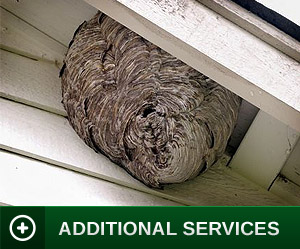 Appearance
Appearance
Within the United States carpenter bees are categorized in two genera – large carpenter bees (Xylocopa) and small carpenter bees (Ceratina). Xylocopa is the group of carpenter bees most likely to make their presence and associated damage known to property owners.
The most obvious characteristic used to separate these two genera is size – Ceratina are less than 8 mm long, while Xylocopa are anywhere from 12-25 mm long. Xylocopa are similar in size and appearance to bumble bees. The insects can be black, greenish black, metallic blue, or purplish blue in color. Males may feature yellow sections of the face. Both males and females have yellowish hairs on the legs, thorax, and abdomen, but these hairs aren’t as vibrant or as numerous as they are on bumble bees.
Also, large carpenter bees differ from bumble bees since they lack visible hairs on the top of the abdomen, giving it a somewhat glossy look.
Small carpenter bees are dark in color and have a somewhat metallic appearance and scant body hairs. The majority of species have some kind of yellow markings on the body and face.
Both genera of carpenter bees go through complete metamorphosis – egg, larva (grub), pupa (cocoon), and adult stage. As solitary insects, carpenter bees do not organize into colonies.
Behavior, Diet, & Habit
Carpenter bees do not eat wood but do feed on plant pollen and nectar; however, they excavate dry, unpainted and weathered wooden objects such as doors, windowsills, roof eaves, railings, decks, untreated poles, fences and wooden lawn furniture. One of their favorite items to excavate is the rails and posts of oak split rail fences. They prefer pine, fir, Cyprus, oak and redwood, especially if the wood is not covered with bark, is unpainted or unfinished. Large carpenter bees sometimes bore into painted wood, especially if the paint covering is old and weathered.
Gallery construction is a labor-intensive process that takes a lot of time and energy. As a result, females often prefer to inhabit existing nests instead of excavating new ones. Refurbished tunnels may increase several feet over several years. When required, females will use their strong mouthparts to chew round nest entrances in flat wood surfaces. This hole is slightly less than 1/2-inch wide, which is about the diameter of her body and looks much like a carpenter used a 1/2-inch drill to create the opening. The bore hole goes into the wood perpendicular to the wood’s grain for about 1-2 inches and then takes a right angle turn continuing as an excavated gallery (tunnel) that runs about 4-8 inches. The female carpenter bee then partitions off brood cells into linear rows. When finished, she places a food ball (made from pollen and regurgitated nectar) inside a brood cell, lays an egg, and blocks the chamber off with chewed wood pulp. After laying eggs, the female dies. The eggs hatch and become larvae that feed on the food ball until they pupate.
Carpenter bees have four life stages: egg, larval, pupal, and adult states. It takes about seven weeks for a carpenter bee to reach adulthood, but developmental time may vary depending on temperate or other environmental conditions. Newly developed adults usually remain in their galleries for several weeks and leave their brood cells in April or May.
They mate, feed on pollen and nectar, return to their gallery to overwinter and then emerge the following spring. Large carpenter bees have one generation per year in the northern states, but in southern states like Florida, they may have two or more generations per year.




